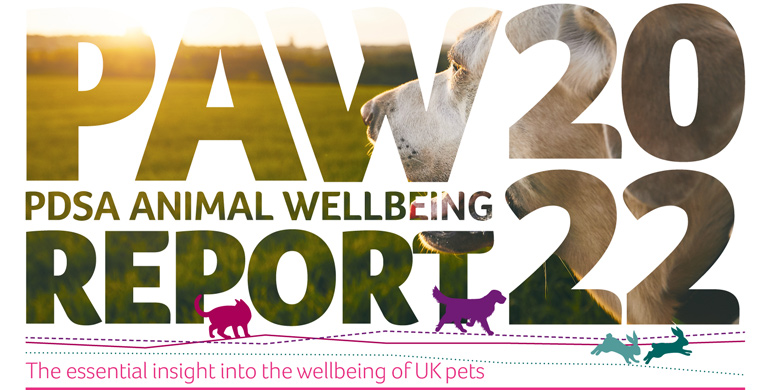Diet and obesity
The legal requirement to feed pets a suitable diet may seem simple to fulfil - 95% of owners told us that they feel well informed about their pet’s dietary needs. However, knowing what diet is appropriate for their pets’ long-term health and wellbeing may be difficult, with a huge amount of conflicting information available. Owners need to be aware of the importance of following evidence-based science and feeding diets that have undergone proper trials with input from nutritional experts.
As in previous years, the main type of food dogs are fed is complete dry food (39%) followed by a mix of wet and dry (35%). 5% are fed commercially prepared raw food and 2% given a homemade raw meat diet, equating to 790,000 UK dogs who are fed a raw diet.
Most cats in the UK are fed a mix of wet and dry food (57%). 1% are fed a homemade raw diet and 1% a commercially prepared raw diet.
The main foods given to pet rabbits are rabbit pellet food (80%), fresh greens (74%) and hay (74%). The large proportion that are fed this ideal diet is encouraging, however,18% of rabbits are still fed a muesli-type diet as one of their main food types. Whilst this is an improvement compared to 2011 when 49% of rabbits received this diet, the figure is unchanged since 2020, meaning that 180,000 rabbits are potentially at risk of health problems due to a poor diet13.
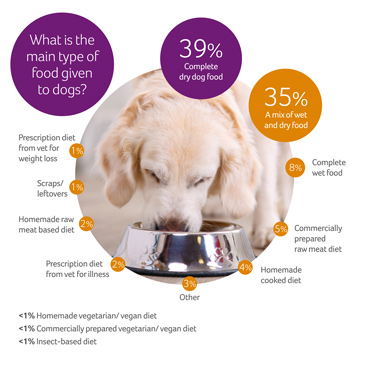
Click the image to expand
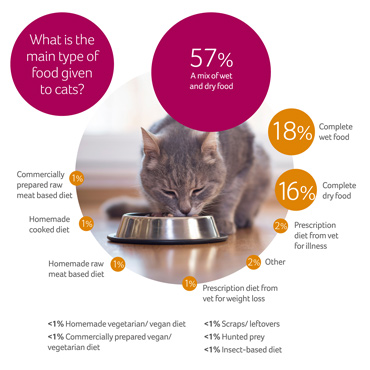
Click the image to expand
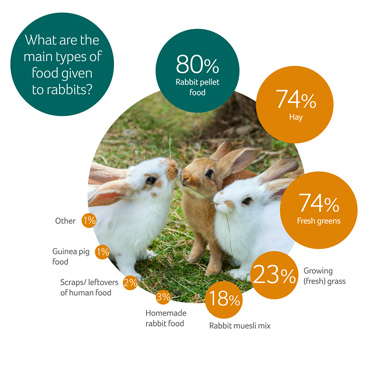
Click the image to expand
Hay or grass is an essential part of rabbits’ diet, needed for digestive and dental health as well as to allow natural behaviours such as foraging, grazing and digging14. 32% of rabbits have constant access to hay or grass, which is ideal15, but 29% say that their rabbit has access to less than their body size of hay or none at all each day which is less than the recommended minimum amount. This has increased compared to February 2020 (22%) but is still an improvement compared to 2011 (45%).
Significantly more rabbit owners feel very well informed about diet (64%) compared to dog owners (55%) and cat owners (46%). Collaborative campaigns between charities, veterinary organisations and pet trade organisations, such as Rabbit Awareness Week, have focused on owner education around issues such as the ideal diet for rabbits, and could have helped this to increase by raising awareness.
60% of owners told us that they regularly give their pet human food in some form, such as leftovers (26%), cheese (22%) and bread or toast (10%). Human food can be high in fats and sugar, and can contribute to obesity and weight problems as well as potentially leading to an unbalanced diet for our pets16.
Despite clinical studies which have found that up to 65% of dogs are obese or overweight17,18, 82% of dog owners told us that their dog was the ideal weight and 78% of cat owners and 87% of rabbit owners told us the same. Less than 1% of dog owners and only 1% of rabbit and cat owners described their pet as obese.
One of the claimed benefits of raw diets is that dogs are less likely to be overweight. Our data found that owners of dogs fed a raw diet, whether homemade or commercial, were less likely to describe their pet as overweight (13%) compared to owners who fed their dogs a homemade (vegetarian or cooked) diet (17%) and a wet complete food (20%). However, there were no difference between raw fed dogs and dogs fed complete dry food being described as overweight (12%).
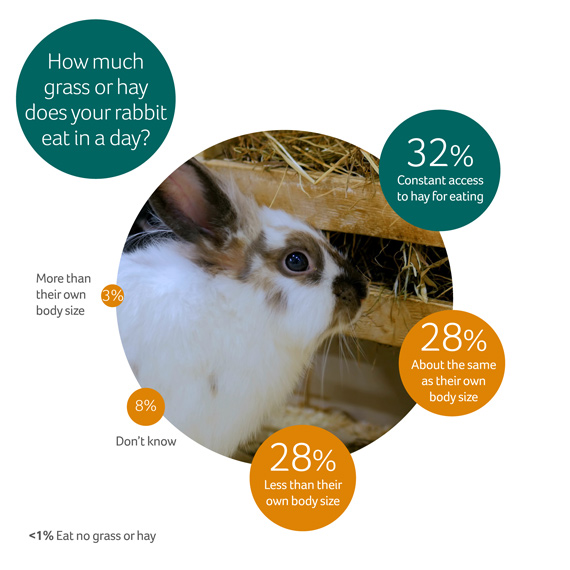
The lack of recognition of obesity amongst owners seems to be increasing. More owners in 2022 describe their pet as being the ideal weight (81%) compared to 2018 (77%) and fewer owners in 2022 describe their pet as being overweight (14%) compared to 2018 (17%).
More pet owners that are registered with a vet are likely to describe their pet as overweight (15%) compared to those not registered (10%). Conversely, a higher proportion of owners who aren’t registered with a vet say that their pet is obese (2%) compared to those who are registered with a vet (0%). These findings are interesting and as yet we don’t know the reasons why. It could be that overweight pets are more likely to have health problems that need veterinary attention but less likely to be obese because of that veterinary intervention and findings could be complicated by some owners’ lack of recognition of weight loss.
Being aware of their pets’ weight or body condition score is an effective tool for owners to manage their pets’ weight19. 64% of dog owners, 41% of cat owners, and 28% of rabbit owners told us that they know their pet’s current weight, while 14% of dog owners, 11% of cat owners, and 14% of rabbit owners know their pet’s body condition score. More owners registered with a vet know their pet’s weight and / or body condition score (59%) compared to those not registered (35%).
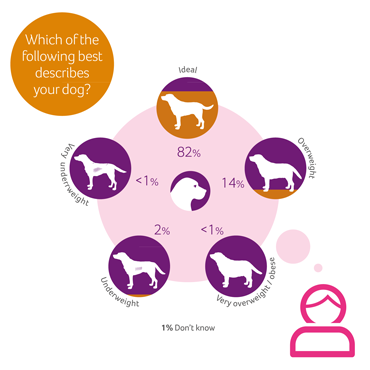
Click the image to see what owners know about their dog's weight
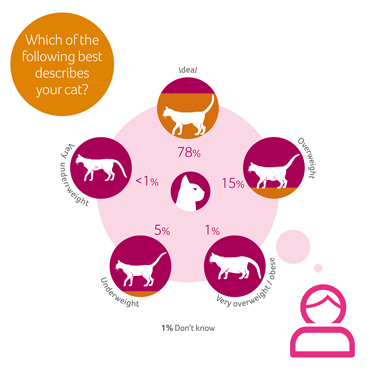
Click the image to see what owners know about their cat's weight
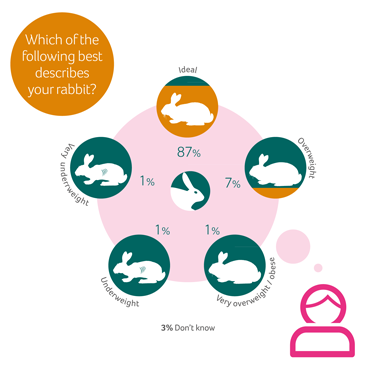
Click the image to see what owners know about their rabbits' weight

Footnotes
13. Prebble, J. L., Langford, F. M., Shaw, D. J., & Meredith, A. L. (2015). The effect of four different feeding regimes on rabbit behaviour. Applied Animal Behaviour Science, 169, 86-92.
14. Lidfors, L. (1997). Behavioural effects of environmental enrichment for individually caged rabbits. Applied Animal Behaviour Science, 52(1-2), 157-169.
15. Clauss,M., Hatt, J.-M. (2017). Evidence-Based Rabbit Housing and Nutrition Vet Clin North Am Exot Anim Pract 20(3), 871-884.
16. Swanson, K. S., Carter, R. A., Yount, T. P., Aretz, J., & Buff, P. R. (2013). Nutritional sustainability of pet foods. Advances in Nutrition, 4(2), 141-150.
17. German AJ, Woods GRT, Holden SL, Brennan L and Burke C 2018 Dangerous trends in pet obesity. Veterinary Record 182: 25. https://doi.org/10.1136/VR.K2
18. Pegram C, Raffan E, White E, Ashworth AH, Brodbelt DC, Church DB and O’Neill DG 2021 Frequency, breed predisposition and demographic risk factors for overweight status in dogs in the UK. Journal of Small Animal Practice 62: 521–530. https://doi.org/10.1111/JSAP.13325
19. Laflamme, D. (2015). Why the Concern Over Obesity: An Introduction. Companion Animal Nutrition Summit, 1-4.

